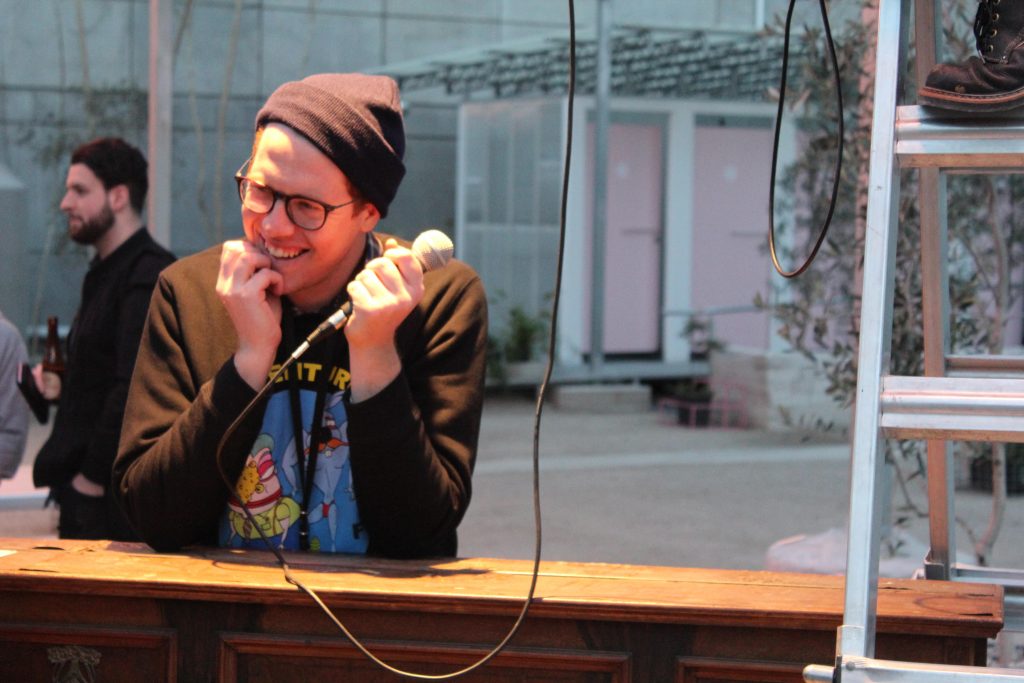
Testing Grounds is an innovative creative hub situated in the Melbourne arts precinct in Southbank. It is built from temporary infrastructure and curated by Arie Rain Glorie, a visual artist himself. Amongst the open artist studios, installations and bustling hipster cafe I sat down to chat with Arie about the history of Testing Grounds and it’s unique ethos within the Melbourne arts landscape.
Firstly, what is Testing Grounds?
AG: Testing Grounds is temporary infrastructure for creative practice supported by the Victorian Government through Creative Victoria. We are a temporary space and have been here for five to six years. ‘Temporary’ not in the sense of ‘pop-up’, we are not for ‘pop-up’ spaces. Testing Grounds has a good life-span and is made with robust materials but has the seeds of destruction built into it from the beginning.
The infrastructure can be removed easily – across the site nothing is embedded into the ground and has been designed in a way that it can be taken apart and moved somewhere else. That is our environmental statement.
As a result we don’t have to worry about longevity. Longevity can be a problem for arts organisations, because as soon as you start worrying about longevity you become risk-averse.
How does Testing Grounds work with artists?
AG: It is a free space for creatives to come and use; artists, designers, architects, anyone who considers themselves to be creative. There is a rolling expression of interest so you can get in touch with us whenever you are ready.
Can you sell artwork at Testing Grounds
AG: Yes, you absolutely can. You can sell tickets to an event, sell artworks and you keep 100% of the proceeds. Testing Grounds do not claim to curate or produce your work, you are responsible for your own work. What we provide is infrastructure and a part of that is programming and project management support. We do curate and produce some of our own projects as well, but on a whole we want to give you the best tools and the agency to make money.
How big is the Testing Grounds team?
AG: I am the one full-time staff member, we have two part-time staff and a few casual workers. We also have an amazing cleaner. The site is cleaned three times a week and that is really important for us.
‘Curator’ comes from Latin word: cura, meaning ‘to take care’, can you elaborate on this?
AG: We talk a lot about ‘care taking’ at Testing Grounds. We are looking after this land which is Crown Land reserved for creative purposes, and it is situated on stolen land. This is the land of the indigenious people, the Wurundjeri and Boon Wurrung people of the Kulin Nation. We are looking after it for the short time that we are here. We also care for the projects in the sense that we ask; What is your project? What do you want to do? And, how can we care for you and your idea?
How has Testing Grounds affected the way visual arts are being presented in Melbourne?
AG: We have definitely seen a shift in the landscape towards things that we feel like we have been talking about for five years. One of them is looking at different styles of programming, one where you can have multiple programs and ideas happening side-by-side and that is okay. It doesn’t have to be fully controlled. Something we do is that we never offer the entire site to one artist or event, you have to share the space with other people and we find that the clashing of programming really works.
I have also written the program in a way that you never have all the spaces open at one, there is always construction going on and things opening and closing at the same time. There is no ‘back of house’ at Testing Grounds and that was intentional because we find that audiences enjoy seeing the work being made as much as they enjoy seeing the finished product.
How many projects did Testing Grounds present in 2018?
AG: We have started talking about Testing Grounds as a year-long festival because last year we supported over 130 projects and there is never not something happening. We are best suited to events and festival-style work because it is a very robust site. At Testing Grounds you can blow things up and set things on fire in a semi-public space.
For me festival-style work really considers audiences. Where as in the gallery world you can get people making work for very different reasons, such as for the artist or for the buyer.
You are a practising artist yourself. Can you talk a bit about your practice and how that has shifted through curating Testing Grounds?
AG: Sure, I am a visual artist working primarily in video and performance art. About five years ago I started curating events, in the role of an artist as curator. I am interested in time and audience engagement. As an independent curator I differ from others in that all I really care about is the audience, whereas most other curators tend to preference the artist first. I also like to experiment and look outside of the visual arts to other disciplines to better understand how audiences work and new learn new methodologies for doing things.
What is happening at Testing Grounds at the moment?
AG: We have a range of things on at the moment. One is CLIMARTE – a climate change art festival and poster exhibition curated by Will Foster. We have Nickk Hertzog, a local artist coming in to work with broken TV’s and looking at glitching. We also have Roshelle Fong doing a live art participatory experience called ‘nomnomnom’ looking at Uber culture, and there will be temporary structures built all over the site. There is also Freeplay and lots more on.
Find out more about Testing Grounds on their website: http://www.testing-grounds.com.au/
Interview/transcription by Renae Shadler
